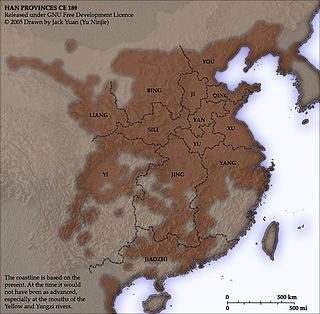| Pu Prefecture | |||||||||
| Chinese | 普 州 | ||||||||
|---|---|---|---|---|---|---|---|---|---|
| |||||||||
Puzhou or Pu Prefecture was a zhou (prefecture) in imperial China, centering on modern Anyue County, Sichuan, China. It existed (intermittently) from 575 until 1376.

Zhou were historical political divisions of China. Formally established during the Han dynasty, zhou exist continuously until the establishment of the Republic of China in 1912—a period of over 2000 years. Zhou were also previously used in Korea, Vietnam, and Japan.

The earliest known written records of the history of China date from as early as 1250 BC, from the Shang dynasty, during the king Wu Ding's reign, who was mentioned as the twenty-first Shang king by the same. Ancient historical texts such as the Records of the Grand Historian and the Bamboo Annals describe a Xia dynasty before the Shang, but no writing is known from the period, and Shang writings do not indicate the existence of the Xia. The Shang ruled in the Yellow River valley, which is commonly held to be the cradle of Chinese civilization. However, Neolithic civilizations originated at various cultural centers along both the Yellow River and Yangtze River. These Yellow River and Yangtze civilizations arose millennia before the Shang. With thousands of years of continuous history, China is one of the world's oldest civilizations, and is regarded as one of the cradles of civilization.

Anyue is a county under the administration of the prefecture-level city of Ziyang in southeastern Sichuan province, China, located in between the Fu and Tuo Rivers. Its area is about 2,690 square kilometres (1,040 sq mi) with a population of 1,538,400. Anyue is famous for its lemon plant and stone carvings.











